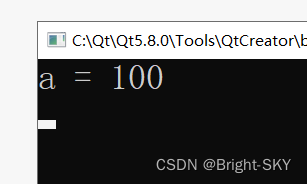C++深入分析讲解类的知识点
目录
- 知识点引入
- 类的初识
- 1、封装
- 2、权限
- 3、类的定义(定义类型)
- 4、类的成员函数与类中声明及类外定义
- Person类的设计
- 设计立方体类
- 点Point和圆Circle的关系
知识点引入
C语言中 数据 和 方法 是独立:
//c语言的思想:数据 方法 分开
//人
typedef struct
{
char name[32];
int age;
}Person;
//动物
typedef struct
{
char name[32];
int age;
int type;
}Dog;
void PersonEat(Person *p)
{
cout<<p->name<<"正在吃饭"<<endl;
}
void DogEat(Dog *d)
{
cout<<d->name<<"正在吃狗粮, 汪汪"<<endl;
}
void test01()
{
Person person = {"老王",43};
Dog dog={"旺财",6};
PersonEat(&person);
DogEat(&dog);
// 出现一个问题(数据 方法独立 容易造成 方法 调用错误数据)
DogEat((Dog *)&person);
}

类的初识
1、封装
把变量(属性)和函数(操作)合成一个整体,封装在一个类中
对变量和函数进行访问控制(公有、私有、保护)
类的封装:将数据和方法封装在一起 加以权限区分 用户只能通过公共方法 访问私有数据。
2、权限
private私有 public公有 protected保护
private私有:类外部不可直接访问私有数据 类内部可以访问
protected保护:类外部不可直接访问私有数据 类内部可以访问
public公有:类外部可以访问私有数据 类内部可以访问
权限只是针对 类的外部 , 类的内部 没有权限之分
class 类名{//抽象的概念 系统不会为其分配空间
private://私有 类的外部 不可直接访问
protected://保护 类的外部 不可直接访问
数据
public://公有 类的外部 可以直接访问
方法
//在类的内部 没有权限之分 都可以相互访问
};
案例:
class Person//抽象的概念
{//类的内部
private:
int m_money;//私有数据
protected:
int m_age;
public:
void dese()
{
m_money = 100;
m_age = 18;
cout<<"我有房 有车 又年轻"<<m_age<<"岁又有钱"<<m_money<<"万美金 我就爱嘚瑟"<<endl;
}
};
void test01()
{
//用类 去 实例化 一个对象(就是用Person定义一个变量)
Person lucy;
//cout<<"兄弟你的钱:"<<lucy.m_money<<endl;//err 内的外部不可访问
//cout<<"兄弟你的年龄:"<<lucy.m_age<<endl;//err 内的外部不可访问
lucy.dese();//ok 公有的类的外部可用访问
//private protected虽然是私有、保护的 类外不可访问 但是用户可以借助 public公有的方法
//间接的访问私有、保护的数据
}
class默认是私有的 数据私有 方法公有 用户就可以借助 公有方法 间接的操作 私有数据
3、类的定义(定义类型)
关键字 class
#include <iostream>
using namespace std;
//类的定义:是不占空间 只有用类实例化 对象的时候 系统为对象开辟空间
class Data
{
private://私有
// int a=10;//err 定义类的时候 尽量不要 给成员赋值
int a;//成员 数据
protected://保护
int b;
public://公有
int c;
//成员函数
void data_show(void)
{
//类的内部:没有权限区分
cout<<a<<", "<<b<<", "<<c<<endl;
}
};
//类中的数据成员 拥有 独立的空间
void test01()
{
//使用Data实例化一个对象名为ob的对象
Data ob;
//成员数据依赖于对象的
//cout<<" ob.a = "<<ob.a<<endl;//err a为私有 类外不能直接访问
//cout<<" ob.b = "<<ob.b<<endl;//err b为保护 类外不能直接访问
cout<<" ob.c = "<<ob.c<<endl;//err c为公有 类外可以直接访问
//对象 通过公共方法 间接调用私用数据
ob.data_show();
}
int main(int argc, char *argv[])
{
test01();
return 0;
}
4、类的成员函数与类中声明及类外定义
class Data2
{
//默认为私有
int a;
public:
//类中声明 类外定义
void setA(int v);
int getA(void);
};
void Data2::setA(int v)
{
a = v;
return;
}
int Data2::getA()
{
return a;
}
void test02()
{
Data2 ob;
ob.setA(100);
cout<<"a = "<<ob.getA()<<endl;
}

Person类的设计
设计一个Person类型
设计一个Person类,Person类具有name和age属性,提供初始化函数(Init),并提供对name和age的 读写函数(set,get),但必须确保age的赋值在有效范围内(0-100),超出有效范围,则拒绝赋值,并提供 方法输出姓名和年龄。
person.h:
#ifndef PERSON_H
#define PERSON_H
//类的头文件:一般定义成员数据 声明成员函数
class Person
{
private:
char m_name[32];
int m_age;
public:
//初始化m_name m_age
void init(char *name, int age);
//设置name
void setName(char *name);
//获取name
char *getName(void);
//设置age
void setAge(int age);
//获取age
int getAge(void);
//显示m_name m_age
void showPerons(void);
};
#endif // PERSON_H
person.cpp:
#include "person.h"
//#include <string.h>
#include<cstring>
#include<iostream>
using namespace std;
//定义类的成员函数
void Person::init(char *name, int age)
{
strcpy(m_name, name);
if(age>=0 && age<=100)
{
m_age = age;
}
else
{
cout<<"年龄输入非法"<<endl;
}
}
void Person::setName(char *name)
{
strcpy(m_name, name);
return;
}
char *Person::getName()
{
return m_name;
}
void Person::setAge(int age)
{
if(age>=0 && age<=100)
{
m_age = age;
}
else
{
cout<<"年龄输入非法"<<endl;
}
return;
}
int Person::getAge()
{
return m_age;
}
void Person::showPerons()
{
cout<<"姓名:"<<m_name<<", 年龄:"<<m_age<<endl;
return;
}
main.cpp
#include <iostream>
#include "person.h"
using namespace std;
int main(int argc, char *argv[])
{
Person ob;
ob.init("lucy", 18);
ob.showPerons();
ob.setName("bob");
cout<<"姓名:"<<ob.getName()<<endl;
ob.setAge(19);
cout<<"年龄:"<<ob.getAge()<<endl;
return 0;
}
设计立方体类
设计立方体类(Cube),求出立方体的面积( 2ab + 2ac + 2bc )和体积( a * b * c),分别用全局函数和成员 函数判断两个立方体是否相等
cube.h
#ifndef CUBE_H
#define CUBE_H
class Cube
{
private:
int m_l;
int m_w;
int m_h;
public:
void setL(int l);
int getL(void);
void setW(int w);
int getW(void);
void setH(int h);
int getH(void);
int getS(void);
int getV(void);
bool compareCube(Cube &ob);
};
#endif // CUBE_H
cube.cpp
#include "cube.h"
void Cube::setL(int l)
{
m_l = l;
return;
}
int Cube::getL()
{
return m_l;
}
void Cube::setW(int w)
{
m_w = w;
return;
}
int Cube::getW()
{
return m_w;
}
void Cube::setH(int h)
{
m_h = h;
return;
}
int Cube::getH()
{
return m_h;
}
int Cube::getS()
{
return (m_l*m_w+m_w*m_h+m_l*m_h)*2;
}
int Cube::getV()
{
return m_l*m_w*m_h;
}
bool Cube::compareCube(Cube &ob)
{
if((m_l==ob.m_l) &&( m_w==ob.m_w) &&(m_h == ob.m_h))
return true;
else
return false;
}
main.cpp
#include <iostream>
#include "cube.h"
using namespace std;
bool myCompareCube(Cube &ob1, Cube &ob2)
{
if((ob1.getL() == ob2.getL()) && \
(ob1.getW() == ob2.getW()) &&(ob1.getH() == ob2.getH()))
{
return true;
}
else
return false;
}
int main(int argc, char *argv[])
{
Cube ob1;
ob1.setL(10);
ob1.setW(10);
ob1.setH(10);
cout<<"面积为:"<<ob1.getS()<<endl;
cout<<"体积为:"<<ob1.getV()<<endl;
Cube ob2;
ob2.setL(10);
ob2.setW(20);
ob2.setH(10);
if(ob1.compareCube(ob2) == true)
{
cout<<"相等"<<endl;
}
else
{
cout<<"不相等"<<endl;
}
if(myCompareCube(ob1, ob2) == true)
{
cout<<"相等"<<endl;
}
else
{
cout<<"不相等"<<endl;
}
return 0;
}
点Point和圆Circle的关系

#include <iostream>
using namespace std;
class Point
{
private:
int m_x;
int m_y;
public:
void setX(int x)
{
m_x = x;
}
int getX(void)
{
return m_x;
}
void setY(int y)
{
m_y = y;
}
int getY(void)
{
return m_y;
}
};
class Circle
{
private:
Point m_p;
int m_r;
public:
void setPoint(int x, int y)
{
m_p.setX(x);
m_p.setY(y);
}
void setR(int r)
{
m_r = r;
}
int getR(void)
{
return m_r;
}
int PointIsOnCircle(Point &p)
{
int tmp_x = (m_p.getX()-p.getX())*(m_p.getX()-p.getX());
int tmp_y = (m_p.getY()-p.getY())*(m_p.getY()-p.getY());
if((tmp_x+tmp_y) > (m_r*m_r))//圆外
{
return 1;
}
else if((tmp_x+tmp_y) == (m_r*m_r))//圆上
{
return 0;
}
else if((tmp_x+tmp_y) < (m_r*m_r))//圆内
{
return -1;
}
}
};
int main(int argc, char *argv[])
{
Point p1;
p1.setX(5);
p1.setY(5);
Circle c1;
c1.setPoint(2,2);
c1.setR(5);
int ret = c1.PointIsOnCircle(p1);
if( ret== 0)
{
cout<<"圆上"<<endl;
}
else if(ret == 1)
{
cout<<"圆外"<<endl;
}
else if(ret == -1)
{
cout<<"圆内"<<endl;
}
return 0;
}

到此这篇关于C++深入分析讲解类的知识点的文章就介绍到这了,更多相关C++类内容请搜索我们以前的文章或继续浏览下面的相关文章希望大家以后多多支持我们!

